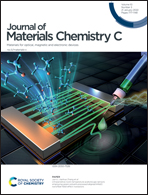Universal co-existence of photovoltaics and ferroelectricity from a two-dimensional 3R bilayer BX (X = P, As, Sb)†‡
Abstract
The intertwined ferroelectricity and photovoltaics in two-dimensional (2D) materials will enable the favorable improvement and control of photovoltaic performances. In this paper, we take 2D 3R bilayer BX (X = P, As, Sb) as prototype systems to study the photovoltaic characteristics of intrinsic 2D out-of-plane (OOP) ferroelectric materials, and try to explore a strategy to regulate the photoelectric properties by changing the strength of ferroelectric polarization. Due to the spatial inversion symmetry broken due to special 3R stacking, spontaneous OOP ferroelectric polarization is induced in the 3R bilayer BX, which can be switchable through specific interlayer sliding. This in turn leads to charge transfer between layers, realizing efficient spatial separation between holes and electrons and forming the characteristics of type-II band alignment. Moreover, due to perfect lattice match of two identical layers, 3R bilayer BX is more stable and easier to realize in experiments compared with most traditional 2D heterostructures made up of different materials. The 3R bilayer BX shows moderate band gap, ultra-high carrier mobility and efficient optical absorption, and its nano-devices present large photocurrent, high photon responsivity and excellent external quantum efficiency. More importantly, all these photoelectric parameters are closely related to the intrinsic OOP ferroelectric strength. By changing the interlayer distance of bilayer BX, ferroelectric polarization can be regulated effectively to achieve an optimal photoelectric performance. Finally, we emphasize the importance and universality of spatial inversion symmetry broken in 2D layered materials beyond the 3R bilayer BX to realize the co-regulation of ferroelectricity and photovoltaics.



 Please wait while we load your content...
Please wait while we load your content...